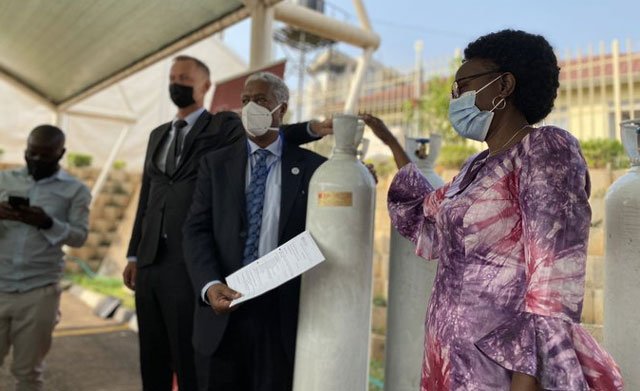
Kampala, Uganda | THE INDEPENDENT | The Ministry of Health has received more than 1000 oxygen cylinders, thanks to the Danish International Development Agency-DANIDA. The Danish agency procured the oxygen cylinders through the World Health Organisation-WHO as part of their donations to Uganda’s response to COVID-19.
Each of the cylinders has a capacity of 6800-litre, which medical professionals say can last at least three days for patients who cannot breathe on their own. The cylinders cost over Shillings 808 million. While handing over the cylinders, Dr. Yonas Wodermariam, the WHO Country representative, said that the cylinders will be a game-changer for COVID-19 patients and those suffering from other diseases.
“Tomorrow or the day after tomorrow in our lifetime, COVID-19 will not be there but these cylinders will be there to support mothers, children and the health system to cope with the demands. Of all things, what you don’t want to have a shortage of is the aerial breath. This support will make sure that people who need it have oxygen so that they can survive. You can survive a day or two without food but for air, you cannot,” Dr Wodermariam said.
During the second wave of COVID-19, which was driven by a more contagious and virulent Delta Variant, the country experienced a shortage of oxygen that led to the loss of several critical patients. The cost of accessing oxygen increased as some people paid as much as Shillings 4 million for one cylinder.
At the height of the second wave, the country had to go to neighbouring Kenya to get oxygen cylinders. The Minister of Health, Dr Jane Ruth Aceng, says that the donation is a big boost to the country’s oxygen supply. According to the Health Ministry, the country needed 8,000 oxygen cylinders at the peak of the second wave of COVID-19.
While many hospitals have oxygen plants, many do not have cylinders. As such the plants become useless given the high commodity demand.
*****
URN
 The Independent Uganda: You get the Truth we Pay the Price
The Independent Uganda: You get the Truth we Pay the Price



An oxygen cylinder is a pressure vessel for storage and transport of oxygen. The first recorded use of an oxygen cylinder was by Joseph Priestley in 1774. Oxygen cylinders are made of aluminium or steel and can be integrated into a breathing apparatus to provide life support. A hole is drilled in the cap of the cylinder to allow for pressure relief, and the valve is protected by a plastic cap. The cylinder must be kept upright at all times to prevent the escape of the gas.